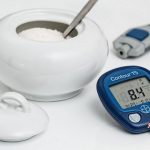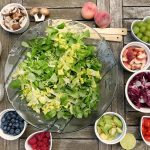Because certain foods, such as carbohydrates, directly impact your blood sugars, your diet is one of the most important factors in managing diabetes. Carbohydrates are found in foods such as grains, fruit, dairy, legumes, and sweets.
When metabolized carbohydrates turn into sugar (glucose), which is the body’s primary source of energy, insulin, a hormone produced by the pancreas, takes glucose from the bloodstream to the cells to use for energy.
When you have diabetes, managing blood sugar can be difficult either because your pancreas isn’t making enough insulin or the insulin it makes isn’t being used efficiently. Learning how to eat a balanced, modified carbohydrate diet can help you lose weight if you need to and better manage your blood sugars. Use a glucometer to monitor your blood sugar at home.
A balanced carbohydrate diet can mean reducing carbohydrate intake, counting carbohydrates, or eating a consistent carbohydrate diet. There are many types of meal plans that can help you lose weight. Spend some time understanding some of the best ways to eat for diabetes to get you jump started.
What’s The Best Diet For Diabetes?
Whether you’re trying to prevent or control diabetes, your nutritional needs are virtually the same as everyone else, so no special foods are necessary. But you do need to pay attention to some of your food choices—most notably the carbohydrates you eat. While following a Mediterranean or other heart-healthy diet can help with this, the most important thing you can do is to lose a little weight.
Losing just 5% to 10% of your total weight can help you lower your blood sugar, blood pressure, and cholesterol levels. Losing weight and eating healthier can also have a profound effect on your mood, energy, and sense of wellbeing. People with diabetes have nearly double the risk of heart disease and are at a greater risk of developing mental health disorders such as depression.
But most cases of type 2 diabetes are preventable and some can even be reversed. Even if you’ve already developed diabetes, it’s not too late to make a positive change. By eating healthier, being more physically active, and losing weight, you can reduce your symptoms.
Taking steps to prevent or control diabetes doesn’t mean living in deprivation; it means eating a tasty, balanced diet that will also boost your energy and improve your mood. You don’t have to give up sweets entirely or resign yourself to a lifetime of bland food.
What Are the Best Ways to Eat for Diabetes?
Educate yourself as much as you can about nutrition. Learn about what foods you can eat, what foods you should limit, when you should eat, and how to portion control your food.
Please note that exact portions differ from person to person based on calorie needs, weight, etc. Here are some great ways to get started.
Practice the Plate Method
The plate method is an easy way to portion control your food without having to directly count your carbohydrates. Its emphasis is on increasing non-starchy vegetables, whole grains, and lean protein.
The plate method can help you increase fiber intake. Fiber-rich foods can help slow down how quickly your blood sugars rise. Eating a high-fiber diet may also help you to lose weight because high-fiber foods are metabolized at a slower pace, which helps you to feel full.
Feeling full more quickly can help to reduce your calorie intake and aid in weight loss. High-fiber foods are also often rich in vitamins and minerals, which boosts your nutrition.
To practice the plate method, simply divide your plate into three. Make half your plate non-starchy vegetables, such as salad, broccoli, string beans, cauliflower, tomatoes, etc.
Dedicate a quarter of your plate to lean protein, such as roasted chicken, grilled or baked fish, or lean meat like sirloin steak. Your portion of protein should be about 3 to 4 ounces (the size of a deck of cards, or the palm of your hand).
Lastly, make a quarter of your plate complex carbohydrates, such as whole grains like quinoa, brown rice, barley, a starchy vegetable like baked sweet potato, or a legume like chickpeas, or black beans. Your portion should be about 1 cup or about a fist full.
You can add some healthy fat to your meal, such as a serving of avocado or olive oil when cooking. A serving of oil is about 1 teaspoon and a portion of avocado is about a quarter of an avocado.
Depending upon your calorie needs, you may be able to increase your intake of fats, too. If you are still hungry after this meal, have another helping of non-starchy vegetables. Be sure to eat slowly and enjoy your food.
Eat a Consistent Carbohydrate Diet
When you have diabetes, you must manage your carbohydrate intake because carbohydrates are the types of foods that impact blood sugar the most. A consistent carbohydrate diet means that you eat about the same amount of complex carbohydrates at the same time daily.
This doesn’t mean you have to eat the same foods daily, but that you aim to eat the same amount of carbohydrates for each meal. For example, if you are instructed to eat 45g of carbohydrates for breakfast and lunch, 15g of carbohydrates for a snack, and 60g of carbohydrates for dinner, you want to try to stick to that daily.
Eating a consistent carbohydrate diet can help to keep your blood sugars steady and prevent fluctuations. For example, if you eat a small amount of carbohydrates for breakfast one day and then have a heavy carbohydrate meal for breakfast the next day, your blood sugars will likely spike. Being consistent helps to keep your blood sugars steady.
If you follow this type of diet, you’ll need to be carbohydrate savvy. You’ll have to be a good carbohydrate counter, know where hidden carbohydrates reside, and have some good carbohydrate counting tools.
READ MORE: Macronutrients – How Much Do You Need?
Limit Certain Types of Food
Limiting certain types of food applies to all people who have diabetes. And quite honestly, even if you don’t have diabetes, limiting these types of foods is part of healthy eating.
Certain types of refined, processed carbohydrates, like white bread, pasta, juice, sweets, cake, and candy, can increase blood sugars rapidly. In addition, they contain very little nutrition and are rich in calories that can cause weight gain.
While many people with diabetes believe they can’t eat fruit, fresh, whole fruit, such as berries, can be part of a diabetes diet. The portion of fruit and how you eat fruit should be carefully considered.
Aim to avoid fruit juice altogether unless your blood sugar is low. Try to keep your fruit servings to about two per day and consider avoiding certain types of fruit like dried fruit and grapes, which can raise blood sugars quickly.
Replace white bread, pasta, and bagels for whole grains such as whole-grain bread or whole-grain pasta. These changes can help to regulate your blood sugar, increase your fiber intake, and boost your nutrition.
Keep in mind that, although you’ve swapped refined carbohydrates for whole grains, portions still matter. For example, if you swap your sugary cereal for oatmeal in the morning, that doesn’t mean you can eat unlimited amounts. The portion of carbohydrates still matters both for calorie control and blood sugar control.
Learn About Portion Control
The quantity of carbohydrates is just as important as the quality of carbohydrates when it comes to managing diabetes. The amount of carbohydrates you need per day can be determined based on your weight, activity level, calorie needs, and how your body responds to carbohydrates.
Discuss with your diabetes educator how many carbohydrates you need per day, so that you can portion control your grams of carbohydrates throughout the day. If you are not interested in carbohydrate counting or you find it too complicated, aim to practice the plate method.
One serving of carbohydrates is about 15g. That doesn’t mean you are limited to 15g per meal, but we use 15g as a reference point. Most people can have about 45g of carbohydrates per meal. Some people benefit from eating less carbohydrates, while others may need more if they are more active or require a higher calorie intake.
Depending on whether you are using the exchange method (an older method for carbohydrate counting) or counting carbohydrates in total grams, your diabetes educator can teach you how to count portions of carbohydrates or total grams.
Eating a balanced diet also means controlling your portions of foods that do not contain carbohydrates, especially if you are trying to lose weight. If you reduce your carbohydrate intake and start to eat endless amounts of cheese (because it is low-carb), odds are you won’t lose weight.
Here are some portions:
- One serving of fruit: 1 whole piece, 1 cup of berries, 1/2 cup mixed fruit or melon, 12-15 grapes or cherries (keep fruit to about 2-3 servings per day)
- One serving of a starch: 1 slice of whole-grain bread, 1/3 cup cooked high-fiber pasta or rice, 1/2 cup cooked oatmeal, 3/4 cup unsweetened cereal, 1/3 cup beans, 1 small potato (size of a computer mouse)
- Protein and fat do not contain carbohydrates, but they still contain calories. Some studies suggest that eating a higher protein, higher fat diet may help to improve blood sugars. Each person should have an individualized meal plan, since what works for you may not work for someone else. Discuss with your healthcare provider if this is right for you.
- Protein: 1 serving per meal is about 3-4 oz, the size of a deck of cards or the palm of your hand.
- Fat: 1 serving is: 1 teaspoon olive oil, 1/3 avocado, 1 teaspoon nut butter. Again, this doesn’t mean this is how much you are limited to per meal. Other foods, such as protein, also contain fat. Some studies have shown that the amount of fat isn’t as important as the quality of fat. Aim to choose healthy fats, such as olive oil, nuts, seeds, avocado. When possible, read labels and stick to one serving. For example: if you are using mayonnaise, or nut butter, read the label and stick to one serving.
- Non-starchy vegetables: 1/2 cup cooked or 1 cup raw. Try to eat about 5-7 servings daily. Non-starchy vegetables are typically one food choice you can eat in unlimited amounts. Load up when you can to help to keep you full.
- Sweets: The American Heart Association suggests that the max amount of added sugars per day be limited to: Men: 150 cal per day (37.5 grams or 9 teaspoons). Women: 100 cal per day (25 grams or 6 teaspoons). Most processed foods have added sugar that counts toward this.
Keep A Food Diary
It’s encouraging to know that you only have to lose 7% of your body weight to cut your risk of diabetes in half. And you don’t have to obsessively count calories or starve yourself to do it. Two of the most helpful strategies involve following a regular eating schedule and recording what you eat.
A recent study found that people who kept a food diary lost twice as much weight as those who didn’t. Why? A written record helps you identify problem areas—such as your afternoon snack or your morning latte—where you’re getting more calories than you realized.
It also increases your awareness of what, why, and how much you’re eating, which helps you cut back on mindless snacking. Keep a notebook handy or use an app to track your eating.
Eat At Regularly Set Times
Your body is better able to regulate blood sugar levels—and your weight—when you maintain a regular meal schedule. Aim for moderate and consistent portion sizes for each meal.
Start your day off with a good breakfast. It will supply power in addition to keeping glucose levels stable. Eat regular small meals—up to 6 per day. Maintaining a regular meal schedule will help you stay on top of your serving sizes.
Keep Calorie Intake The Same
To regulate blood sugar levels, try to eat roughly the same amount every day, rather than overeating one day or at one meal, and then skimping the next.
Get More Active
Exercise can help you manage your weight and may improve your insulin sensitivity. An easy way to start exercising is to walk for 30 minutes a day (or for three 10-minute sessions if that’s easier). You can also try swimming, biking, or any other moderate-intensity activity that has you working up a light sweat and breathing harder.
Takeaway
Eating a healthy diet is one of the most important ways to manage diabetes. While it may seem difficult, it is controllable. And today we are not only bombarded with unhealthy food preferences, but we are also inundated with healthy ones.
America has jumped on the healthy eating bandwagon. Utilize all the resources you have at hand. Set small, tangible goals, and embrace all your wins. You can eat healthy and enjoy it too.









